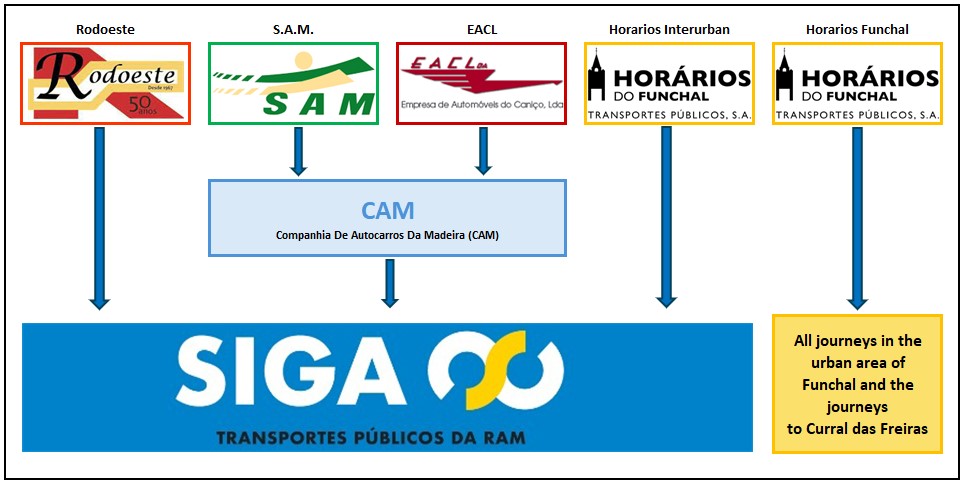Aerobus

New departure times for the Aerobus! The new departure times will apply from 1 April 2025. These are the departure and arrival points: 01 = Airport 26 = Praia Formosa (hotel district in Funchal) Overview of stops Notes on the overview of stops The small arrows in blue and orange) in front of the minutes indicate the time that must be added to the departure times shown above. You will then have the correct departure time for your stop. Example:You want to travel from Avenida do Infante (stop 10) in the direction of the airport.This means that you need to add between 10-20 minutes to the specified time.So instead of 10:00 (starting point Praia Formosa / no. 26), the bus departs at 10:10 (or 10:20 if there are disruptions) from Avenida do Infante. We wish you a safe journey! 🚌
SIGA – 7 Months Later

SIGA – 7 Months And Now? On July 1, 2024, SIGA launched with the goal of significantly improving and simplifying bus operations on Madeira. However, according to recent press reports, the planned changes remain largely invisible even seven months later. The only noticeable update so far has been the renewal of the bus fleet, with the acquisition of 124 new Iveco vehicles. What we still miss, unfortunately, is a mobile app to check current schedule changes. Additionally, there’s no option to pay for tickets onboard or via an app using a card. Until today, it is not possible for tourists to purchase weekly or monthly passes. An onboard ticketing system is also still nowhere in sight. Ticket purchase with tradition 😉 For tourists in particular, it’s a challenge to always have enough coins ready to buy tickets directly from the driver (currently the only option for trips outside Funchal). It’s easy to see how this procedure causes delays and disruptions in the bus schedules. According to today’s report in the Diário, SIGA is now at risk of an early shutdown. However, we are confident that it won’t come to that, as the state has a responsibility to maintain public transportation. If Madeira is unable to sustain this project, the government in Lisbon will surely find a way to ensure that Madeira’s buses continue to operate reliably and on time. We’ll stay on top of this story and keep you updated.
SIGA – Overview

SIGA – Everything Under One Roof Now The Beginning Public bus transportation on Madeira has a long and interesting history, closely tied to the island’s economic and infrastructural development. Until the 20th century, Madeira was dominated by agricultural activities, particularly wine and sugar production. At that time, transportation within the island was a challenge, as the steep slopes and rough roads made access to remote areas difficult. The first public transport services on Madeira emerged in the early 1900s, when horse-drawn carriages were the only means of transporting people and goods. By the 1920s, motorized buses were introduced, significantly easing and modernizing transport. Funchal, the capital, played a central role, as most bus routes originated there. Expansion in the 20th Century With Madeira’s economic development, especially through growing tourism, the bus system on the island became increasingly important. In the 1950s and 1960s, public transport experienced a major boom, with several private bus companies being established, specializing in transporting locals and tourists alike. Two of the most well-known companies that still exist today are Horários do Funchal, which mainly focuses on city traffic in Funchal, and Rodoeste, which covers the west of the island. These companies made remote areas more accessible and improved the mobility of the local population. Modernization and Sustainability In recent years, Madeira’s public transportation has been modernized. Newer, more environmentally friendly buses have been introduced to meet the demands of growing tourism and environmental protection efforts. At the same time, the network has been expanded to reach even more villages and regions. Until June 30, 2024, four companies were responsible for public bus services on Madeira. A simplified overview: On July 1, 2024, all regional bus services (everything outside Funchal) were consolidated under the umbrella organization SIGA. As part of this, the online timetables of individual bus companies were discontinued and are now only available in limited form online. The goal of this „friendly takeover“ is to create unified structures, such as better fare management (previously, separate tickets had to be purchased for each bus company). As shown in the graphic, the SIGA network serves as the umbrella organization and is operated by three concessionaires: Companhia de Autocarros da Madeira (CAM), Siga Rodoeste, and Horários do Funchal (HF). Foresight Today, Madeira’s buses are considered one of the best ways to explore the island. They offer an affordable alternative to renting a car and allow tourists an authentic insight into the island’s diverse landscapes and cultural highlights. The bus system helps reduce traffic and protect the environment.Find out more in the guide: Madeira by Bus